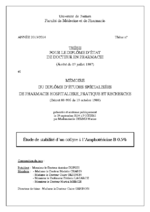Thèse d'exercice
Dermu Marine
Étude de stabilité d’un collyre à l’Amphotéricine B 0.5%
FrançaisConsulter le texte intégral (format PDF)

Résumé
Français
Étude de stabilité d’un collyre à l’Amphotéricine B 0.5%
Background and Objective:
Amphotericin B ophthalmic solutions, manufactured by the Hospital Pharmacy, are regularly administered as treatment for fungal keratitis. Until now, the stability of Amphotericin B ophthalmic solution has only been shown under refrigerated conditions and for a short period. We performed a stability study in order to assess its stability in the freezer (-20°C) over 2 months and for a further use during 4 days at 4-8°C. Such a stability length could allow us to prepare this compounding preparation beforehand, it would also facilitate the distribution and speed up the provision in order to begin the treatment as early as possible.
Setting and Method:
The quantitative analysis was performed with a HPLC-UV method previously validated according to ICH guidelines (the method has been tested in terms of specificity, linearity, accuracy and fidelity). The 0,5% (w/v) Amphotericin B eye drops were prepared from the branded product and diluted with glucose 5% and sodium carbonate, and performed according to recommendations for aseptic preparation. The vials were then placed at -20°C (monitored) and stored for up to 60 days, protected from light. Vials were analysed at 0, 7, 15, 30 days. The stability study has been conducted according to SFPC and Gerpac's Guidelines for Stability Study. After 30 and 60 days, the vials were also stored for the 4 following days under refrigerated conditions to mimic the use by the outpatients and then subsequently analysed each of these days.
Chemical stability was assessed when less than 10% difference from initial concentration was observed. Physical stability was assessed using visual inspection, osmolality, coloration using UV-Visible spectrophotometry and pH assay. As high microbiological risk compounding preparation, the sterility has also been assessed in Pharmacopoeia broths (Thioglycolate and Trypticase soja).
Results:
There were no significant differences before the storage and after 7, 15, 30 and 60 days of freezing in the concentration (0.49 w/v ± 0.029), osmolality (344.40 mOsm/kg ± 14.31), turbidimetry and pH (7.76 ± 0.17) of the solutions. There were no significant differences either in the concentration and physical parameters during the 4-days storage under refrigerated conditions.
Conclusion:
Amphotericin B eye drops can be stored for 60 days at -20 °C. After this time, these eye-drops should be stored at 4°C and safely used during 4 days following vial opening, provided it is properly used and stored.
Mots-clés libres : Amphotericin B, ophthalmic solutions, drug stability, keratitis, terapeutics .
- Collyres
- Kératite
Notice
- Diplôme :
- Diplôme d'état de Pharmacie
- Établissement de soutenance :
- Université de Poitiers
- UFR, institut ou école :
- Domaine de recherche :
- Pharmacie
- Directeur(s) du travail :
- Claire Grignon
- Date de soutenance :
- 19 septembre 2014
- Président du jury :
- Antoine Dupuis
- Membres du jury :
- Claire Grignon, Michèle Chabin, Frédéric Lagarce, Martial Mercié
Menu :
-
-
à propos d'UPétille
-
Voir aussi
Annexe :

-
Une question ?
Avec le service Ubib.fr, posez votre question par chat à un bibliothécaire dans la fenêtre ci-dessous ou par messagerie électronique 7j/7 - 24h/24h, une réponse vous sera adressée sous 48h.
Accédez au formulaire...
Université de Poitiers - 15, rue de l'Hôtel Dieu - 86034 POITIERS Cedex - France - Tél : (33) (0)5 49 45 30 00 - Fax : (33) (0)5 49 45 30 50
petille@support.univ-poitiers.fr -
Crédits et mentions légales
